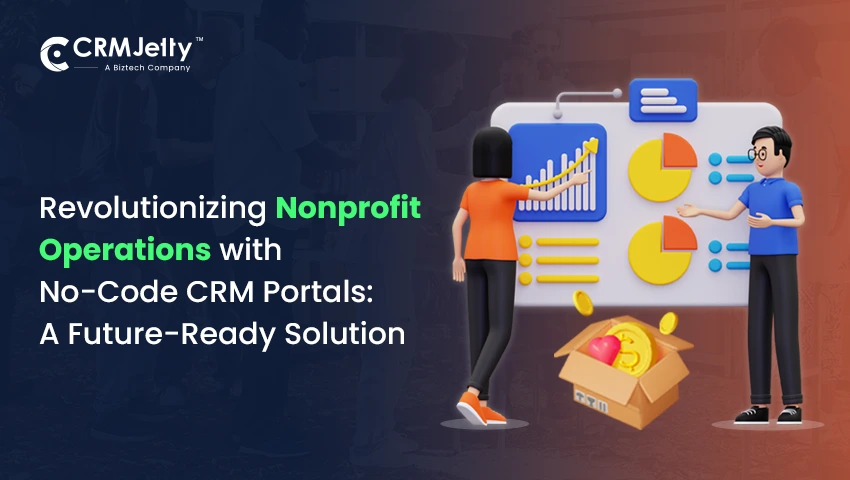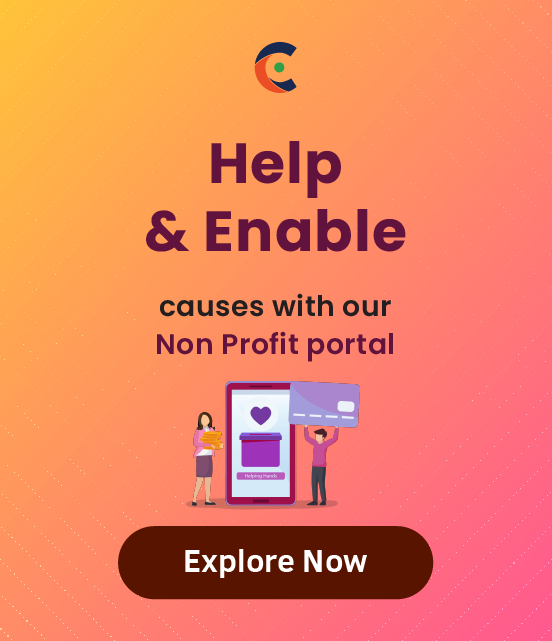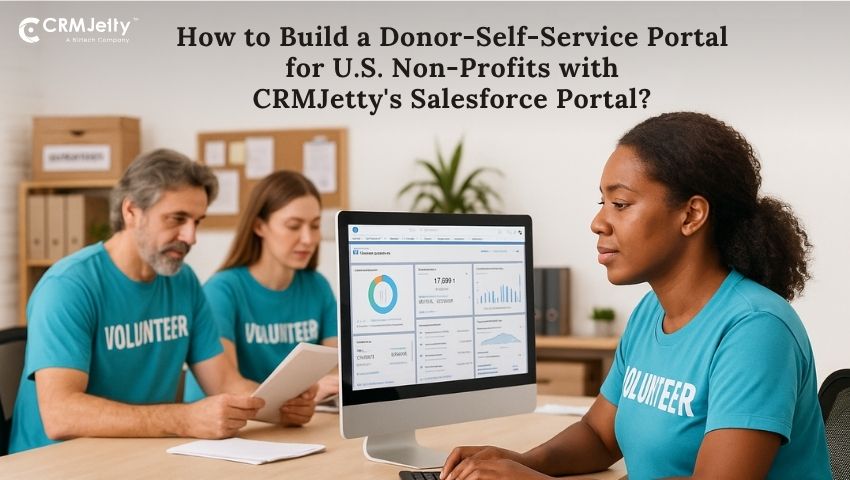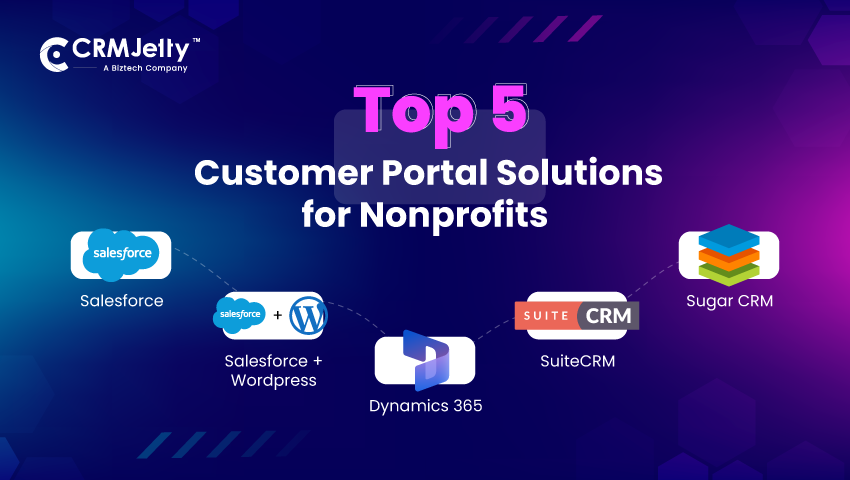Digital-first nonprofits retain 53% of donors versus the sector average of just 41–45%. That 8–12% improvement is a catalyst for mission growth.
Supporters today expect more than acknowledgement. They want insight, convenience, and a sense of belonging. Yet many organizations still treat CRM as a backend tool, not a bridge to real stakeholder connectivity.
The result? Donors wait for updates, volunteers chase confirmations, and staff juggle redundant tasks across multiple systems.
No-code CRM portals shift that dynamic. They extend your CRM into a real-time, branded interface where donors, volunteers, and internal teams can self-serve. No coding, automated workflows, and data-driven clarity.
Let’s explore how this operational evolution can translate into stronger loyalty, smoother workflows, and amplified impact.
Current Challenges in Nonprofit Processes
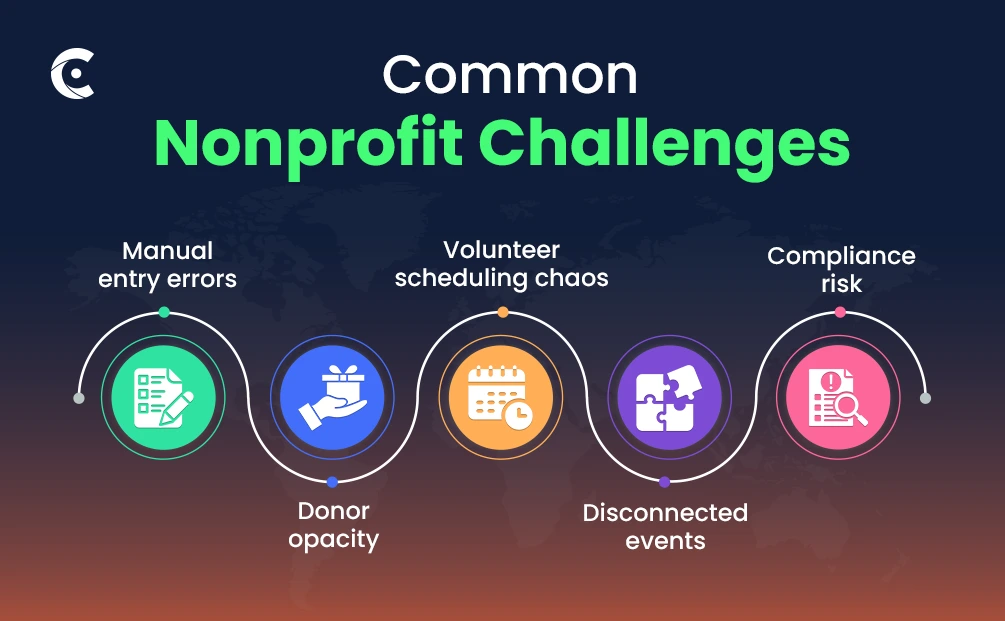
To deliver a smooth and interactive experience to donors, volunteers, and internal teams, you need a nonprofit portal, or you might face the following challenges:
Manual Entry and Errors
Staff often spend hours entering data from handwritten forms or emails. This not only slows down operations but also increases the chance of human error. Incorrect or outdated information can lead to poor decisions and lost opportunities.
Limited Donor Transparency
Donors often don’t have access to their donation history or updates on how their contributions are making a difference. This lack of visibility can weaken donor trust and reduce long-term engagement.
Volunteer Scheduling Chaos
Volunteer coordination is typically managed through spreadsheets or email. This can lead to scheduling conflicts, double-bookings, and frustrated volunteers.
Disconnected Event Management
Event planning is often siloed from other systems. Attendance, feedback, and RSVP data are rarely synced, making it hard to track engagement.
Compliance Risk
Grant tracking and documentation are often unstructured. This leads to missed deadlines, errors, and audit risks.
These problems not only strain teams but also hurt relationships with critical stakeholders.
Why CRM Alone Isn’t Enough
CRMs like Salesforce are essential for managing data behind the scenes. But they fall short when it comes to connecting with the people outside your organization. Without a portal layer, key gaps remain.
- Volunteers and donors can’t self-serve, which means your staff spends hours handling routine tasks like updating contact details, confirming participation, or answering basic queries.
- Communication remains fragmented across emails, phone calls, and PDFs. Important updates get lost or delayed. This patchwork system makes coordination harder than it needs to be.
- Opportunities for engagement and transparency are lost. Donors have no easy way to view their donation history or see the impact of their contributions. Volunteers can’t check schedules or updates in one place. Without visibility, it’s harder to build trust.
- Manual updates create duplicate work and increase the risk of errors. Staff often re-enter the same data across systems, which slows things down and hurts CRM reliability.
Your CRM holds your data. A portal activates it for the people who matter most.
What You Gain with a No-Code Nonprofit Portal
Nonprofits need more than data management. They need meaningful stakeholder experiences that build trust, loyalty, and inspire action. CRMJetty’s no-code portal platform transforms CRMs into full-fledged engagement ecosystems.
Stakeholder expectations have evolved. Donors want transparency. They want to see where their money is going and how it makes a difference. Volunteers expect clear schedules and responsibilities so they can contribute without confusion or delays. Staff members want workflows that simplify daily tasks. They look for automation that reduces manual work and keeps information up to date across systems.
Experience Cloud and community portals offer a starting point but often fall short. They come with rigid templates, limited design options, and require technical help to make even small updates. Custom-built portals can solve these issues but are costly to create, difficult to maintain, and take a long time to deploy.
CRMJetty bridges this gap with a CRM portal for nonprofits. It is designed to be:
- Self-managed by nonprofit teams: You don’t need a developer to make updates. Your team can control content, settings, and workflows on their own.
- Integrated with Salesforce in real time: Data updates in the portal sync instantly with your CRM. There is no delay or manual export needed.
- Secure and customizable without coding: The portal includes built-in user roles, permissions, and branding options. You can create the experience you want with no technical help.
- Donors’ Payment Gateway: Donors can give directly through the portal using secure payment gateways. This reduces friction in the donation process and encourages recurring contributions. Transaction data also syncs with your CRM for accurate reporting.
- Ready-to-use integrations: Whether you need calendar tools for event scheduling, e-signatures for forms, or messaging tools for communication, the portal supports plug-and-play integrations. These self-service donor portal features save time and reduce the need for third-party tools.
This shift redefines your portal. It becomes a stakeholder-first experience platform, not just a CRM add-on. It empowers every user to engage more meaningfully with your mission.
Use Cases: Where CRM Falls Short and Portals Deliver
CRMs have limits, portals fill the gaps. Let’s see how, in specific and real situations, a nonprofit management portal can help you!
Scenario 1: Volunteer Management
2. Screen Flow: Use Case 1 (Volunteer Scheduling)
The Problem:
Nonprofits often rely on email chains and spreadsheets to schedule and manage volunteers. This approach leads to frequent double-bookings and last-minute confusion. Volunteers might sign up but never receive confirmation or reminders. Others may miss out because their availability was overlooked. Without a unified system, staff spend too much time coordinating over back-and-forth emails. It becomes hard to track who signed up, who actually showed up, and how many hours were served. This not only creates a poor experience for volunteers but also makes reporting and recognition difficult.
The Solution:
A nonprofit Salesforce portal is the answer to all your problems. Volunteers can create profiles, list their availability, and sign up for events that match their interests. Once confirmed, they receive automatic notifications and reminders. Coordinators can easily view and manage the full schedule in real-time. The nonprofit Salesforce portal tracks attendance and volunteer hours, syncing all data directly with the CRM. This setup ensures accuracy while reducing manual work for staff. It also improves the volunteer experience, making it easier for them to stay engaged and informed. Over time, this leads to stronger relationships with committed volunteers and better support for your nonprofit’s mission.
Scenario 2: Donor Engagement and Transparency
The Problem:
Many nonprofits still rely on one-way communication when engaging with donors. Receipts go out via email. Impact reports are generic and sent periodically. Donors often have no easy way to view their donation history, update payment information, or see how their money is making a difference. This lack of transparency can weaken trust. When donors do want to engage or make changes, they often need to call or email staff, creating delays and adding to the administrative burden. Over time, these gaps in experience can lead to donor fatigue or drop-off.
The Solution:
With a nonprofit Salesforce portal you can offer donors a personalized, secure dashboard. Donors can log in anytime to view their donation history, download receipts, and see project-specific updates tied to their contributions. They can update contact or payment details without needing staff support. The portal can also display tailored impact stories and program milestones, giving donors a real sense of connection to the cause. All interactions are synced with the CRM in real-time. This builds transparency and trust, encourages repeat donation, and reduces the workload on internal teams. Donor engagement portal transforms donor relationships from transactional to ongoing and engaged.
Scenario 3: Volunteer Onboarding and Scheduling
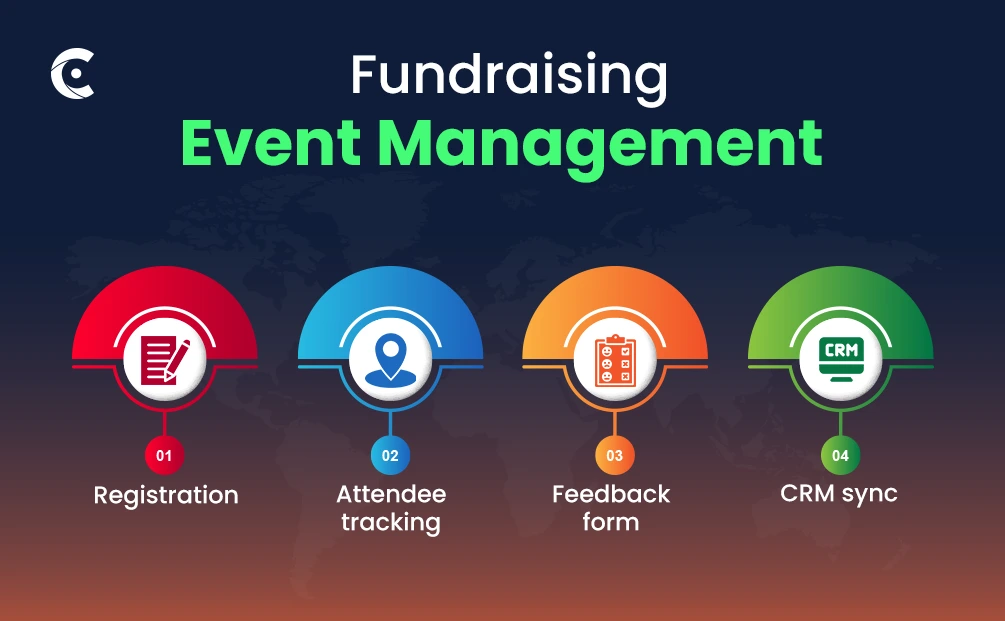
The Problem:
Volunteer coordination often involves a messy mix of spreadsheets, emails, and phone calls. Signups are collected through static forms, and scheduling is handled manually. This leads to double-bookings, gaps in coverage, and constant back-and-forth. Volunteers may not know where to go or what to expect. New volunteer onboarding is equally slow. Staff spend hours sending welcome packets, gathering documents, and answering basic questions. These manual processes make it hard to scale volunteer programs and create inconsistent experiences that discourage long-term involvement.
The Solution:
A volunteer portal connected to your CRM gives volunteers a self-serve experience from the start. New volunteers can sign up, complete onboarding steps, and upload necessary documents—all through one interface. They can view upcoming events, sign up for shifts, and get automatic reminders. Any updates they make are instantly reflected in Salesforce, keeping your records clean. Staff can also post training materials and updates in one central place. This reduces manual coordination and gives volunteers the clarity and autonomy they expect. With real-time scheduling and centralized communication, your volunteer program becomes easier to manage and more rewarding to join.
Scenario 4: Grant Tracking and Document Management
The Problem:
Nonprofits often manage grant deadlines and milestones using spreadsheets. This approach is fragile. Spreadsheets can be accidentally deleted or edited. They also lack visibility across teams. Deadlines are missed. Follow-ups get lost in long email threads. At the same time, grant-related documents are scattered across shared folders with unclear access rights. Staff waste time hunting for the latest versions. This disorganization can delay submissions and increase the risk of non-compliance during audits.
How CRMJetty Solved It:
CRMJetty’s grant management portal brings structure to the chaos. All grant milestones, deadlines, and submission timelines are tracked in one place. Teams get automated alerts when deadlines are near. Documents are stored with version control, so only the latest file is used. Access can be role-based, ensuring that only the right people can edit or view sensitive information. There will be real-time CRM sync for nonprofits. This system reduces manual tracking and helps teams stay ahead of deadlines, improving both efficiency and compliance.
The No-Code Portal Solution: Seamless, Scalable, Self-Managed
CRMJetty’s no-code nonprofit portal makes it easy to launch a powerful and scalable engagement solution without needing a development team. It is designed for both your internal staff and your external stakeholders, helping you create better experiences across the board.
Built for Admins
The portal puts control in the hands of your admin team. With simple drag and drop tools, they can build custom forms, event registration modules, and volunteer schedules. No technical expertise is required. Role-based access controls ensure that users only see what they need. Be it managing internal workflows or external users, your team can configure it all through a simple interface.
Built for Stakeholders
Volunteers, donors, and partners can log in to their own dashboards. They can sign up for events, upload documents, update their profiles, and track their donations. Everything is mobile-friendly and ready for multiple languages. It is built to serve your diverse community with clarity and ease.
Salesforce Synced
All portal activities sync with Salesforce in real time. There is no data lag or duplication. CRMJetty nonprofit portal becomes the single source of truth across your organization. What your team sees is exactly what’s in your CRM.
Self-Managed
There is no need for custom coding or outside maintenance contracts. Your team can launch the portal, make updates, and expand it as needed. You go live faster. You adapt faster. You engage better. All while staying secure and compliant.
The Results That Matter
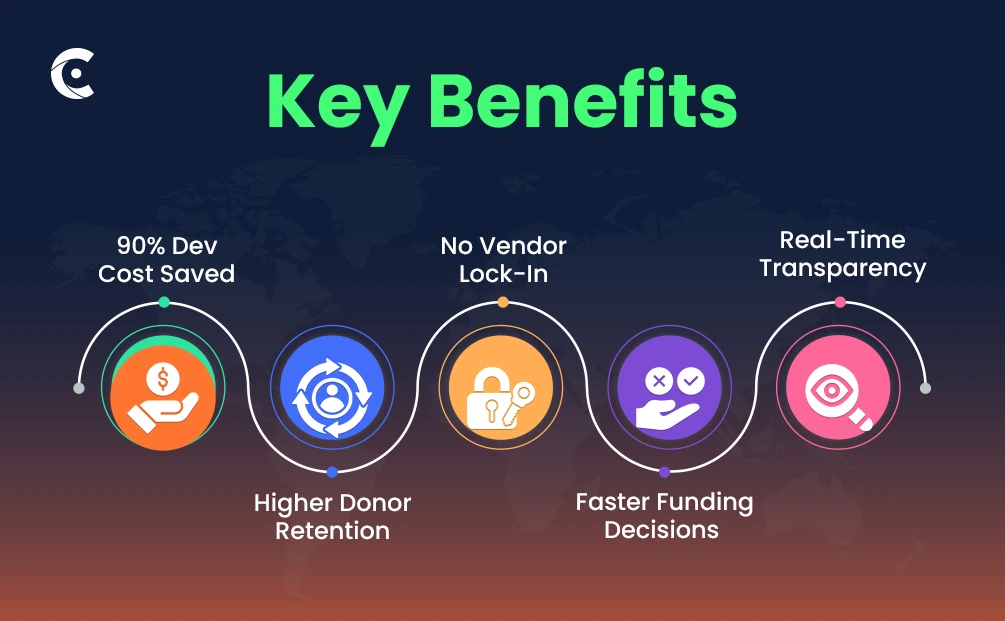
- Save 90% of Development Effort: Building a custom portal can take months and requires a full development team. CRMJetty’s low-code CRM portal for NGOs cuts that effort by up to 90 percent. You can launch faster, make updates without coding, and lower your total cost of ownership significantly.
- Enhanced Stakeholder Satisfaction: Donors, volunteers, and partners expect transparency and instant access. With our portal, they can view donation history, upcoming events, volunteer schedules, and relevant documents in real time. This improves engagement and builds stronger relationships with the people who support your mission.
- No Ongoing Maintenance Costs: Traditional portals often come with long-term vendor contracts or constant developer involvement. CRMJetty puts your team in charge. You can manage, update, and grow the portal on your own terms without being tied to ongoing maintenance retainers.
- Faster Funding and Higher Retention: Donors want to see results. Grantmakers want timely reports. CRMJetty no-code portal for nonprofits, makes it easy to share impact through real-time dashboards and structured reporting tools. This builds trust, speeds up funding cycles, and helps you retain both donors and volunteers over time.
All product and company names are trademarks™, registered® or copyright© trademarks of their respective holders. Use of them does not imply any affiliation with or endorsement by them.


